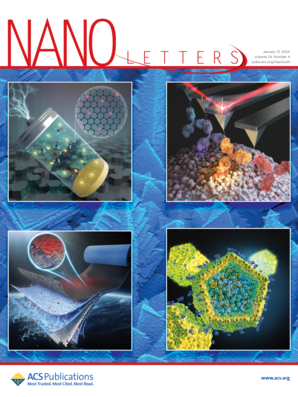Ti3C2Tx MXenes中超快电子-声子和电子-电子散射的相互作用:从头算量子动力学
IF 9.6
1区 材料科学
Q1 CHEMISTRY, MULTIDISCIPLINARY
引用次数: 0
摘要
非热电子在太阳能和光电子学中是至关重要的,但它们的弛豫途径尚未完全了解。从头算量子动力学表明,Ti3C2O2中的电子-声子(e-ph)弛豫比电子-电子(e-e)散射更快,这是由于Ti3C2O2中与A1g声子在190 cm-1处的强耦合以及光C和O原子的存在。核量子效应很小;振动对e-e散射的影响仅是间接的,且A1g模式的零点能量远低于环境条件下的热能。在Ti3C2OS中用较重的S取代O减慢了e-ph弛豫,增强了e-e散射,使其成为一个更快的过程。然而,这两个通道同时进行,挑战了通常用于金属的e-e和e-ph时间尺度分离。这些结果强调了对非热电子动力学的原子级理解的必要性,特别是在像MXenes这样的轻元素系统中,并为优化先进光电材料和器件中的电子弛豫提供了指导。本文章由计算机程序翻译,如有差异,请以英文原文为准。

Interplay of Ultrafast Electron–Phonon and Electron–Electron Scattering in Ti3C2Tx MXenes: Ab Initio Quantum Dynamics
Nonthermal electrons are vital in solar energy and optoelectronics, yet their relaxation pathways are not fully understood. Ab initio quantum dynamics reveal that in Ti3C2O2 electron–phonon (e-ph) relaxation is faster than electron–electron (e-e) scattering due to strong coupling with the A1g phonon at 190 cm–1 and the presence of light C and O atoms. Nuclear quantum effects are minimal; vibrations influence e-e scattering only indirectly, and the A1g mode’ zero-point energy is much lower than thermal energy at ambient conditions. Substituting O with heavier S in Ti3C2OS slows e-ph relaxation and enhances e-e scattering, making it a faster process. However, both channels proceed concurrently, challenging the e-e and e-ph time scale separation often used for metals. These results underscore the need for atomistic-level understanding of nonthermal electron dynamics, especially in light-element systems such as MXenes, and provide guidance for optimizing electronic relaxation in advanced optoelectronic materials and devices.
求助全文
通过发布文献求助,成功后即可免费获取论文全文。
去求助
来源期刊

Nano Letters
工程技术-材料科学:综合
CiteScore
16.80
自引率
2.80%
发文量
1182
审稿时长
1.4 months
期刊介绍:
Nano Letters serves as a dynamic platform for promptly disseminating original results in fundamental, applied, and emerging research across all facets of nanoscience and nanotechnology. A pivotal criterion for inclusion within Nano Letters is the convergence of at least two different areas or disciplines, ensuring a rich interdisciplinary scope. The journal is dedicated to fostering exploration in diverse areas, including:
- Experimental and theoretical findings on physical, chemical, and biological phenomena at the nanoscale
- Synthesis, characterization, and processing of organic, inorganic, polymer, and hybrid nanomaterials through physical, chemical, and biological methodologies
- Modeling and simulation of synthetic, assembly, and interaction processes
- Realization of integrated nanostructures and nano-engineered devices exhibiting advanced performance
- Applications of nanoscale materials in living and environmental systems
Nano Letters is committed to advancing and showcasing groundbreaking research that intersects various domains, fostering innovation and collaboration in the ever-evolving field of nanoscience and nanotechnology.
 求助内容:
求助内容: 应助结果提醒方式:
应助结果提醒方式:


